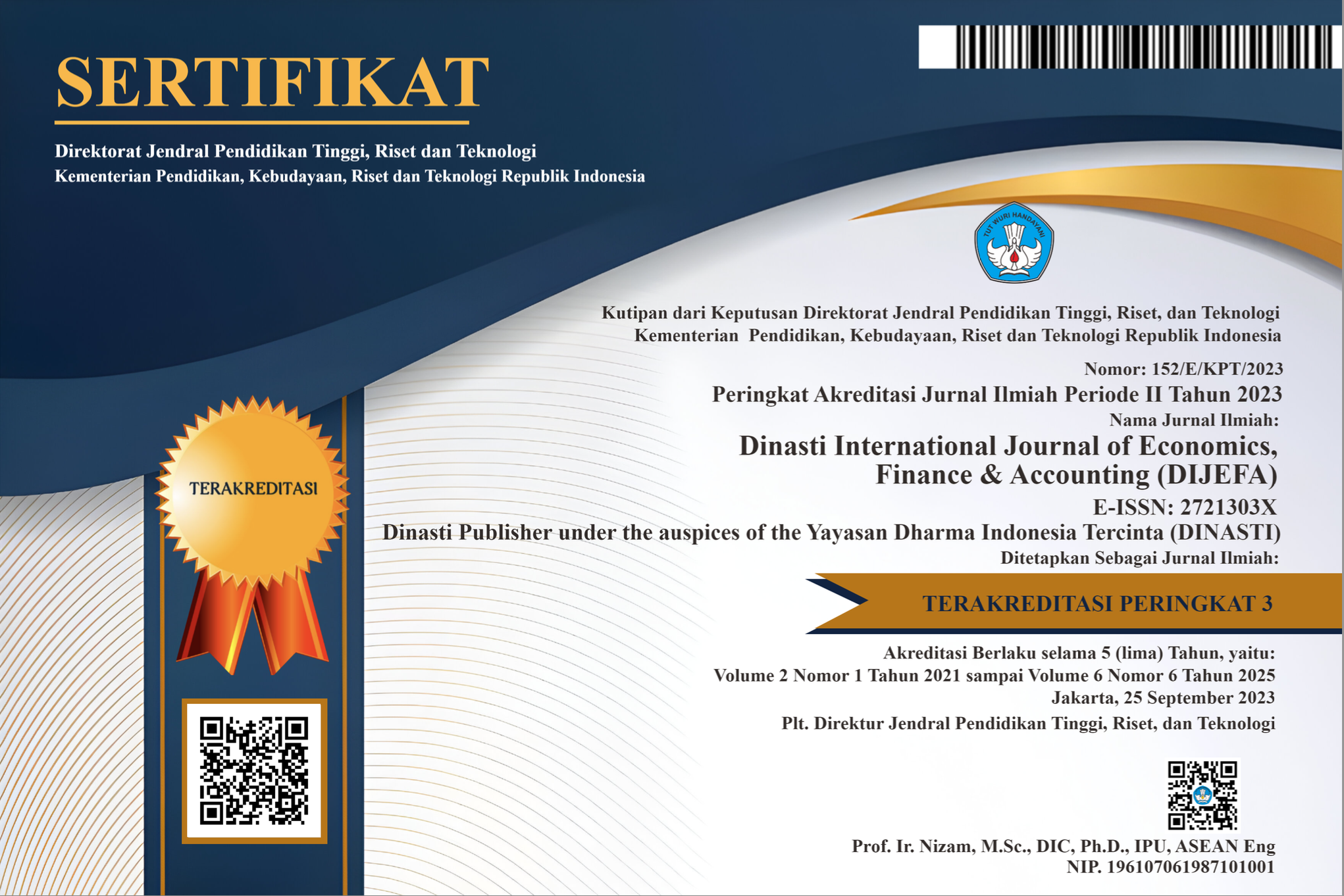Green Repurchase Intention of Wiguna Market Visitors: The Role of Green Perceived Value, Green Perceived Quality, Green Wom With Green Trust As Mediation
DOI:
https://doi.org/10.38035/dijefa.v5i6.3797Keywords:
Green Perceived Value, Green Perceived Quality, Green WOM, Green Repurchase Intention, Green TrustAbstract
Now green marketing is one of the marketing strategies as a positive response to the situation of the earth and consumers who are starting to care about the environment. Green repurchase intention is one of the targets and objectives of green marketing. Increasing demand for environmentally friendly products is the focus of several researchers to contribute to providing the best marketing solutions for environmentally friendly products and the consumer segments that are their target markets. Pasar Wiguna is one of the communities in Yogyakarta that is committed to being a place for consumers to participate in protecting the earth from the aspect of sustainable product consumption, maintaining a supply chain that cares about the environment from the beginning to the end of the product. Therefore, research on green repurchase intention is very suitable for visitors to Pasar Wiguna. This study aims to analyze the role of green perceived value, green perceived quality, green WOM on green repurchase intention with green trust as a mediator. Data collection was carried out through a survey of buyers of environmentally friendly products or community visitors and/or visitors who had visited Pasar Wiguna Yogyakarta for the second time or more. The proposed hypothesis was completed with the PLS-SEM model through Smart-PLS1 software. The results are that Green Trust fully mediates the relationship between Green Perceived Value and Green Repurchase Intention; Green Trust fully mediates the relationship between Green Perceived Quality and Green Repurchase Intention; Green Trust does not mediate the relationship between Green WOM and Green Repurchase Intention.
References
Kirgiz, A. C. (2016). Green Marketing: A Case Study of the sub-Industry in Turkey. UK: Palgrave Macmillan
Putri, K. T. K., & Sukawati, T. G. R. (2020). e Role of Trust Mediates the Effect of Customer satisfaction on Repurchase Intention (Study on Consumer Chatime) in Denpasar City. American Journal of Humanities and Social Sciences Research, 4(8), 412–418.
Sabono, D., & Murwaningsari, E. (2022). The Influence of Green Perceived Value, Green Perceived Quality, and Green Perceived Risk On Green Repurchase Intention With Green Trust As Intervening Variable. Glob. J. Account. Econ. Res, 3, 107-129.
Guerreiro, J., & Pacheco, M. (2021). How green trust, consumer brand engagement and green word-of-mouth mediate purchasing intentions. Sustainability, 13(14), 7877.
Ariffin, S., Yusof, J. M., Putit, L., & Shah, M. I. A. (2016). Factors influencing perceived quality and repurchase intention towards green products. Procedia Economics and Finance, 37, 391-396.
Lam, A. Y. C., Lau, M. M., & Cheung, R. (2016). Modelling The Relationship Among Green Perceived Value, Green Trust, Satisfaction, And Repurchase Intention of Green Products. Contemporary Management Research, 12(1), 47–60.
Hair, J. F., Hult, G. T. M., Ringle, C. M., & Sarstedt, M. (2022). A Primer on Partial Least Squares Structural Equation Modeling (PLS-SEM) (3 ed.). SAGE.
Chen, Y. L., & Weng, C. (2015). The Influence of Environmental Friendliness on Green Trust: The Mediation Effects of Green Satisfaction and Green Perceived Quality. Sustainability, 10135–10152.
Chen, Y. S., & Chang, C. H. (2013). Towards green trust The influences of green perceived quality, green perceived risk, and green satisfaction. Journal of Management Decision, Vol. 51 No. 1, 63–82.
Hair, Joseph. F., Hult, G. Tomas. M., Ringle, Christian. M., & Sarstedt, M. (2017). A Primer on Partial Least Squares Structural Equation Modeling (PLS-SEM) (2 ed.). California: SAGE Publications, Inc.
Mauliawan, Y. R., & Nurcaya, I. N. (2021). The Role of Price Sensitivity and Green Knowledge Moderate the Influence of Eco-Label and Eco-Brand on Repurchase Intention in Green Product ( Study of Sensatia Botanicals Product Consumers in Denpasar , Bali , Indonesia). American Journal of Humanities and Social Sciences Research (AJHSSR), 5(1), 657–663.
Putra, I. B. A. S. A., & Pramudana, K. A. S. (2021). Open Access The Role of Trust Mediates Effect of Customer Experience on Repurchase Intention. American Journal of Humanities and Social Sciences Research (AJHSSR), 5(1), 80–85.
Rahardjo., F. A. (2015). The Roles Of Green Perceived Value, Green Perceived Risk Towards Green Purchase Intention Of Inverter Air Conditioner in Surabaya. iBuss Management, 3(2), 252–260.
Setiawan, W., & Fitria, S. E. (2016). Analysis of ecopreneur motivation to achieve green economy in the region district of Bandung (Study case bank sampah bersinar). E-Proceeding of Management, 3 (3), 2828–2833.
Tapia, F. C. (2013). Assessing Sustainable Behavior and its Correlates: a Measure of ProEcological, Frugal, Altruistic and Equitable Actions, Sustainability (Vol. 5).
Utami, I. G. A. A., & Ekawati, N. W. (2020). The Role Of Customer Satisfaction Mediated Perception Of Value And Service Quality To Customer Loyalty. American Journal of Humanities and Social Sciences Research (AJHSSR, 4(2), 165–174.
Fund, S. (2015). Sustainable development goals. Available at this link: https://www. un. org/sustainabledevelopment/inequality.
Downloads
Published
How to Cite
Issue
Section
License
Copyright (c) 2025 Fransisca Desiana Pranatasari, Maria Angela Diva VW

This work is licensed under a Creative Commons Attribution 4.0 International License.
Authors who publish their manuscripts in this journal agree to the following conditions:
- The copyright on each article belongs to the author(s).
- The author acknowledges that the Dinasti International Journal of Economics, Finance & Accounting (DIJEFA) has the right to be the first to publish with a Creative Commons Attribution 4.0 International license (Attribution 4.0 International (CC BY 4.0).
- Authors can submit articles separately, arrange for the non-exclusive distribution of manuscripts that have been published in this journal into other versions (e.g., sent to the author's institutional repository, publication into books, etc.), by acknowledging that the manuscript has been published for the first time in the Dinasti International Journal of Economics, Finance & Accounting (DIJEFA).


























































